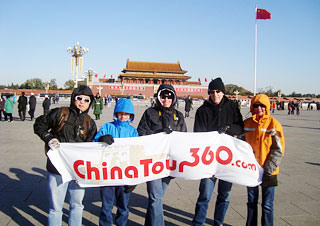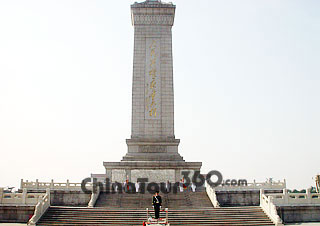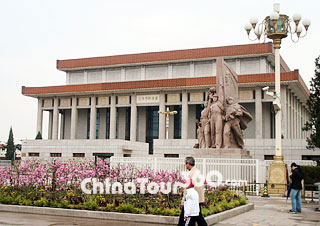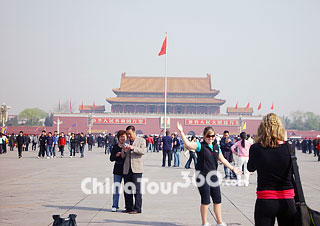 Tour on Tiananmen Square
Tour on Tiananmen Square Monument to People's Heroes
Monument to People's Heroes Mao Zedong Memorial Hall
Mao Zedong Memorial Hall National Museum of China
National Museum of China Tiananmen Square, Beijing
Tiananmen Square, Beijing
Located in the heart of Beijing City, Tiananmen Square is the largest city center square in the world, covering an area of 44 hectares. It is the place where numerous significant political and historical events occurred. It is also the witness of China's history from declining to rising. In 1986, it was selected in the '16 scenic spots in Beijing'.
Having a capacity of one million persons, Tiananmen Square is 500 meters (601 yards) wide from east to west and 880 meters (962 yards) long from north to south. The whole ground is paved with light-color granite stone strips processed through special technology. The main road in the central part of the square measures 390 meters (427 yards) long and 80 meters (87 yards) wide, allowing a parade of 120 arrays to pass through at the same time.
Standing on the square and looking around, visitors will find that Zhengyangmen and Tiananmen Tower, standing on their original position, have become the north-south boundary line of the new square instead of being the vanguards of the imperial palace in ancient China. More over, there are many other magnificent buildings, such as the central Monument to People's Heroes, the southern Memorial Hall of Chairman Mao, the eastern Great Hall of the People and the western National Museum of China. All of these new and old buildings integrate with each other harmoniously, presenting distinctive national features.
The ceremonies of flag-raising at sunrise and flag-lowering at sunset are the most spectacular, attracting tens of thousands of visitors daily.
![]() Tiananmen Tower
Tiananmen Tower
Being the landmark of the square, Tiananmen Tower was once the main entrance to the Forbidden City in the Ming and Qing dynasties. During that period, many grand ceremonies were held on the tower, such as a new emperor's accession, wedding and heaven worship. In front of the tower there is a river named Jishui River (Golden Water River), over which were built 7 stone bridges with railings carved with white jade. Of them, the widest one in the middle is called 'Yulu Bridge (imperial road bridge)', especially built for emperors. In the Ming and Qing dynasties, the area outside tower served as a court square, where was forbidden for ordinary people. Nowadays, visitors can cross the gate to visit Forbidden City with a ticket. Click for detailed information about Tiananmen Tower
![]() Monument to People's Heroes
Monument to People's Heroes
Established on April 22, 1958, Monument to People's Heroes lies in the center of the square. It was built in memory of the people's heroes who laid down their lives in the Chinese People's War of Liberation and the Chinese People's Revolution. In 1961, it was listed as one of China's foremost protected monuments by the State Council of China. The stone in the central part of the monument is a huge whole granite that is rare in the Chinese architectural history, weighing around one hundred tons. The quarry and transport of the stone took seven and a half months. On the front of the monument was inscribed with 'Eternal Glory to the Heroes of the People' by Chairman Mao. There are also elaborately carved embossment patterns on the body and on the top of the monument. These are lovely and well worth a close look.
![]() Memorial Hall of Chairman Mao
Memorial Hall of Chairman Mao
Memorial Hall of Chairman Mao, in the southern part of Tiananmen Square, was built in memory of Mao Zedong who is the founder father of the People's Republic of China. It was completed on May 24th, 1977, covering an area of over 5.7 hectares. It is square-shaped, with 44 granite columns standing outside. In the magnificent hall was laid the remain of Mao Zedong which is respected by visitors at home and abroad in an endless stream daily. The hall is mainly made up of the Northern Hall, Respecting Hall and Southern Hall. The Northern Hall is for holding commemorative activities. The Respecting Hall, core of the memorial hall, has a crystal sarcophagus in the center, in which the remain of Chairman Mao is kept. The Southern hall is the exit hall, whose white marble walls were carved with Chairman Mao's poetry - Reply to Comrade Gao Moruo.
![]() Great Hall of the People
Great Hall of the People
The Great Hall of the People stands on the western side of Tiannamen Square and the southern side of West Chang'an Street. It is the place where NPC holds meetings and where NPC and NPC Standing Committee work. It is also an important place for the Chinese leaders and people to hold political, diplomatic and cultural activities.
Facing east, the Great Hall of the People is 336 meters (367 yards) long from north to south, 206 meters (225 yards) wide from east to west, and 46.5 meters (153 feet) high. It covers an area of 15 hectares, with a floor space of 17 hectares. Except there are important conferences, visitors have access to the Central Hall, 10000-Seat Auditorium, Guest Hall and Banquet Hall.
![]() National Centre for the Performing Arts
National Centre for the Performing Arts
Going westward from the Great Hall of the People, visitors will see the ellipsoid-dome-shaped National Centre for the Performing Arts. It is composed of a main building, underwater long corridors on the northern and southern sides, an underground parking lot, an artificial lake and greenbelts, covering an area of 11.89 hectares. As a landmark and one of the '16 scenic spots in Beijing', National Centre for the Performing Arts doesn't only improve the surrounding environment with its clear water, green land, trees and flowers, but it also reflects the concept of the harmonious combinations of people and people, people and art, and people and nature. Click for detailed information about National Centre for the Performing Arts.
National Centre for the Performing Arts has 4 theatres, namely, the central Opera Theatre, the eastern Concert hall, the western Drama Theatre and the Small Theatre on the west side of the south gate. They stand alone, and are linked one another through aerial walkways. A lot of supporting facilities for the theaters have also been set up.
Being the largest dome in the world, the National Centre for the Performing Arts' steel structure weighs 6,475 tons, with a span of 212.2 meters (232 yards) from east to west. It is also the deepest architecture in Beijing, with its foundation reaching an impressive 32.5 meters (107 feet) underground. The pipe organ in the Concert Hall, biggest one in Asia, has 6,500 sounding pipes, costing 30 million RMB.
![]() China National Museum
China National Museum
Located on the eastern side of Tiananmen Square, China National Museum stands symmetrically with the Great Hall of the People. It is a comprehensive museum, specializing in showing the culture and history of China. It was built on the combination of the original Chinese History Museum and Chinese Revolutionary Museum in February, 2003. On March 1st, 2011, the newly built China National Museum was completed and opened to the public. Click for detailed information about China National Museum
![]() Entrance Fee: Free (CNY 15 for tower ascending)
Entrance Fee: Free (CNY 15 for tower ascending)
![]() Transportation:
Transportation:
A. Bus Routes: Take Bus No. 1, 2, 5, 7, 9, 10, 17, 20, 22, 44, 48, 53, 54, 59, 110, 120, 309(Branch), T1, T2, T3, T4, 703, 726, 729, 742, 803, 808, 819, 826, 848, 859 or 922 and get off at Tiananmen or Qianmen Stop.
B. Subway:
Take Subway Line 1, and get off at Tiananmen East or West;
Take Subway Line 2, and get off at Qianmen.








